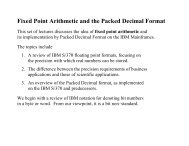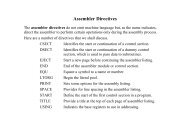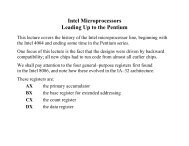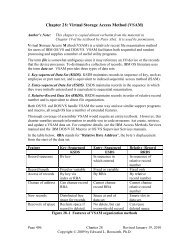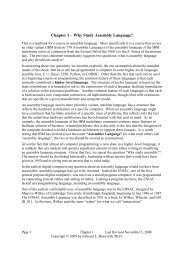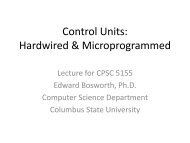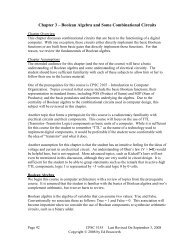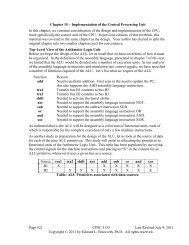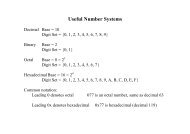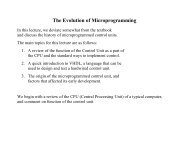PDF Version - Edwardbosworth.com
PDF Version - Edwardbosworth.com
PDF Version - Edwardbosworth.com
Create successful ePaper yourself
Turn your PDF publications into a flip-book with our unique Google optimized e-Paper software.
S/370 Assembler Language Binary Integer Data<br />
Consider the code fragment below.<br />
LH R7,=H‘100’<br />
After this, register R7 contains the full–word value +100, as shown below.<br />
Left half–word<br />
Right half–word<br />
0 – 3 4 – 7 8 – 11 12 – 15 16 – 19 20 – 23 24 – 27 28 – 31<br />
0000 0000 0000 0000 0000 0000 0110 0100<br />
Now consider the code fragment.<br />
LH R8,=H‘-100’<br />
After this, register R8 contains the full–word value –100, as shown below.<br />
Left half–word<br />
Right half–word<br />
0 – 3 4 – 7 8 – 11 12 – 15 16 – 19 20 – 23 24 – 27 28 – 31<br />
1111 1111 1111 1111 1111 1111 1001 1100<br />
LR (Load Register) and LCR (Load Complement Register)<br />
Each instruction is a type RR, with formatLR R1,R2. The opcode forLR isX‘18’.<br />
The opcode forLCR isX‘13’. The object code format for each is as follows.<br />
Type Bytes Operands<br />
RR 2 R1,R2 OP R 1 R 2<br />
Each operand specifies any general–purpose register. The contents of the register specified<br />
as the second operand are copied into the register specified as the first operand.<br />
Consider the code fragment below.<br />
L R9,=H‘200’ REGISTER 9 GETS DECIMAL 200<br />
LR R7,R9 REGISTER 7 ALSO GETS 200<br />
THIS TIME IT IS COPIED FROM R9<br />
LCR R8,R9<br />
REGISTER 8 GETS DECIMAL -200, STORED<br />
IN PROPER 2’S-COMPLEMENT FORMAT.<br />
LM (Load Multiple Registers)<br />
The LM instruction loads data from main storage into more than one register.<br />
The instruction is a type RS with formatLM R1,R3,D2(B2). The opcode isX‘98’.<br />
This is a four–byte instruction with object code format as follows:<br />
Type Bytes Operands 1 2 3 4<br />
RS 4 R1,R3,D2(B2) X‘98’ R 1 R 3 B 2 D 2 D 2 D 2<br />
The first byte contains the 8–bit instruction code.<br />
The second byte contains two 4–bit fields, each of which encodes a register number. These<br />
two bytes specify the range of registers to be loaded.<br />
The third and fourth bytes together contain a 4–bit register number and 12–bit displacement<br />
used to specify the memory address of the operand in storage. This operand is considered as<br />
the first fullword a block of fullwords; the size of the block is determined by the number of<br />
registers specified in byte 2. This is a type RS instruction; indexed addressing is not used.<br />
Page 228 Chapter 12 Last Revised July 6, 2009<br />
Copyright © 2009 by Edward L. Bosworth, Ph.D.



